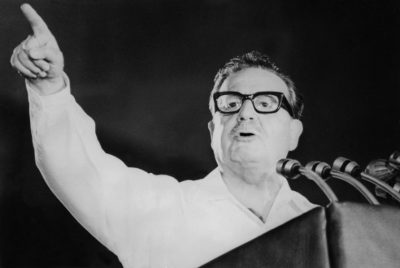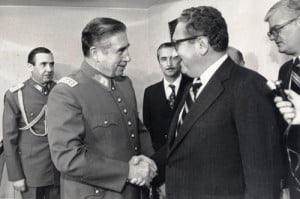‘Virus’ of Nationalism Has Been Smashed Repeatedly with Dictatorships Installed by the US
US foreign policy has often been directed toward destroying the threat of independence.

Among the more significant cases of United States’ determination in preventing independent nationalism, is with regard to Chile.
The Chilean example, starting under its 1970 democratically elected president Salvador Allende, was a telling one. Firstly, it lies in the Western Hemisphere. Indeed, Chile is “only” about 5,000 miles from the US border, and an independent path here was deemed an unacceptable threat.
In 1970, President Richard Nixon ordered the CIA to “make the [Chilean] economy scream” in order to “prevent Allende from coming to power or unseat him”. Nixon feared that Chile would become “another Cuba”. Despite friendly relations with Cuban leader Fidel Castro, Allende himself was not a Communist.
The Chilean President was a social democrat of the European model. Allende was born into a privileged family, who had a tradition of political involvement in progressive causes. Allende studied at the University of Chile, following his grandfather’s footsteps by becoming a physician.
“I don’t see why we need to stand by and watch a country go Communist due to the irresponsibility of its people. The issues are much too important for the Chilean voters to be left to decide for themselves”.
The crime of the Chilean people was its “irresponsibility” in wanting a brighter future for themselves. Kissinger further said that the “virus” of independence had to be crushed before it “spread contagion”. Allende’s presidential palace was bombed, with the president himself dying in the aftermath, along with thousands of others.

Augusto Pinochet and Henry Kissinger (Source: Ministerio de Relaciones Exteriores de Chile / Wikimedia (CC BY 2.0 CL))
The murderous dictator Augusto Pinochet was installed in 1973, whom CIA reports had described as “hard working” and “honest”. In the midst of the bloodshed and economic inequality, Pinochet also stole $26 million of Chilean cash. He hid the millions in 120 bank accounts, many of them located offshore, while using bogus passports.
The suffering of Chileans paled in comparison to those in Vietnam and the rest of Indochina. When Allende was toppled in 1973, the war against Vietnam was reaching its agonising late stages with US troops finally pulling out. As with Chile, American concerns about Vietnam were primarily with regard independent policy – and its potential spread to the resource laden regions of south-east Asia.
In the early 1950s, the US had opposed rising Vietnamese nationalism, while supporting French efforts to re-colonize its former territory. This failed when the French were routed in early May 1954, by Ho Chi Minh’s Communist Viet Minh coalition.
This resulted in a political settlement the same year, at the Geneva Conference in Switzerland, which split Vietnam into two states, in the Korean mode. The US regarded these peace accords as “a disaster”, and prevented it from proceeding.
During the next year (1955), the US erected a puppet state in South Vietnam led by the dictator, Ngo Dinh Diem. It was a classic Western client regime, carrying out murders and torture on a vast scale. By the early 1960s Diem’s policies most likely killed between 70,000 to 80,000 people. This was all before the war against Vietnam had even begun.
Diem’s cruel suppression only led to increased resistance against his regime. By 1961, the situation was “out of control” with Diem close to being toppled by popular resistance. This would have been a shattering outcome for US strategic planners.
They were terrified of a “domino effect”. If the entirety of Vietnam came under Communist control, it could conceivably extend to other countries. Malaysia could be next. Or, worst of all, Indonesia – described by Richard Nixon in 1967 as “the greatest prize”, with its abundant riches.
The unmatched might of the US military was called upon. In early 1962, President John F. Kennedy directed the US Air Force to bomb South Vietnam en masse – disguising American aircraft with South Vietnamese markings. So began the 13-year war.
In 1963, the Kennedy administration learned the dictator Diem was making attempts at a peace deal with Communist North Vietnam. Kennedy and his liberal cabinet subsequently organized a coup in which Diem and his brother, Ngo Dinh Nhu, were assassinated. The war against Vietnam escalated until Kennedy himself was killed in late November 1963.
The conflict in Vietnam was continued with vigour by Presidents Lyndon B. Johnson and Nixon – as “secret wars” spread to the rest of Indochina, Laos and Cambodia. Little is known about the scale of destruction against these defenseless countries. Laos, which is slightly smaller than Britain, suffered the misery of being the most bombed nation in history.
Nor was the punishment limited to Indochina. Indonesia, just over a thousand miles east of Vietnam, was also harassed mercilessly. In 1965, American intervention led to the democratically elected President Ahmed Sukarno being unseated after two decades in power.
President Sukarno was described by the famous Indonesian writer, Pramoedya Ananta Toer, as “the only Asian leader of the modern era able to unify people of such differing ethnic, cultural and religious backgrounds without shedding a drop of blood”.
Much blood would be shed during the following 33-year reign of his Western-backed successor, General Hajji Suharto (in power, 1965-1998). Indeed, the Suharto regime inflicted “one of the worst mass murders of the 20th century”.
The bloodshed rivalled Stalin’s purges. Up to a million people, mostly landless Indonesian peasants, were killed during widespread massacres against Communists, or Communist sympathisers, or simply anyone in the way.
With the body count having piled up during the initial genocide of 1965-1966, American corporations waded through the blood to pillage Indonesian resources. Suharto’s “paradise for investors” was to be exploited for full Western benefit.
James Reston, the New York Times’ then prominent voice, described the Suharto takeover as “a gleam of light in Asia”. Reston’s analysis was typical of mainstream commentary of Suharto. For over 20 years, one of the worst mass murderers of the post-World War II period was described as “a moderate leader”, “a moderating voice”, or “at heart benign”, someone who brought “stability” to the region. Later, the Bill Clinton administration described Suharto as “our kind of guy”.
The list continues. America supported apartheid South Africa in the 1970s and 1980s – while also backing Jonas Savimbi’s terrorist UNITA forces in Angola, 900 miles north of South Africa.
The US continued unabashed in their support for the monstrous Savimbi. This despite a CIA account describing him as “terribly brutal” and that “it wasn’t a good idea” to help him. Savimbi was even invited to the White House to meet Ronald Reagan, and later, George H. W. Bush.
In the meantime, South African terrorists were driven out of Angola by Cuban-led forces in early 1976. Years later, troops loyal to Fidel Castro also forced South Africa to end its illegal occupation of neighboring Namibia. America’s backing of South Africa’s racist regime continued right to the end of Reagan’s second term, in 1989.
That same year a UN report outlined that South African assaults on Namibia, Angola and Mozambique resulted in around 1.5 million lives lost.
Elsewhere in the 1980s, terrorist operations orchestrated by the Reagan administration cost about 200,000 lives across Latin America. It was called the first “war on terror”, as immediately declared by Reagan upon taking office in 1981.
In the Middle East, a rough estimate of four million people have died since the 1991 Gulf War to the current day. Indeed, the death toll may even be higher as a result of Western aggression, to prevent independence and allow control over oil resources. Nobody knows the precise body count in the Middle East, as the crimes have never been investigated.
*
This article was originally published by The Duran.
Shane Quinn obtained an honors journalism degree. He is interested in writing primarily on foreign affairs, having been inspired by authors like Noam Chomsky.

